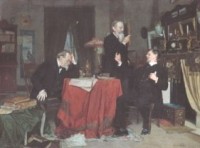Leadership is the ability to act as a magnet for the intelligence and creativity of others.
Effective speakers act as a magnet for the intelligence and creativity of the listener.
Effective listeners act as a magnet for the intelligence and creativity of the speaker.
Presence of Mind: Clear Thinking
I help leaders write and speak powerfully so that what emerges is the product of thought rather than the process of thinking.
The business world requires leaders who can synthesize and present intricate, subtle ideas simply. So, for the record, here is what I believe: You can’t be that kind of leader unless you write well.
Writing well means many things: distilling vast amounts of data into a powerful storyline for a presentation; crafting a brief email that reveals both your clarity and your humanity; creating a blog to help you build relationships with a global team.
Writing well is hard work. But writing is not the hardest work: thinking is. Thinking is so hard that we probably invented writing to make thinking easier.
I’ve spent over twenty years helping leaders exploit the power of writing to increase their leadership impact. The stakes are high, and so are the rewards:
- The way an organization writes reveals how it thinks. The way you write reveals how you think. Improve the writing and inevitably you improve the quality of the thinking.
- Writing is itself a form of leadership. Your team, your peers — and perhaps even your own senior leaders — look to you, look at your writing, to see how to get things said so that things get done. To write well means to lead well—and to act as editor, coach, and mentor.
There’s a lot riding on your writing. I’ve spent more than twenty years helping executives think, write, and lead with clarity.
Presence of Ear: Superb Listening
I help leaders listen superbly so that when they respond, they’re able to combine their ideas with the ideas of others in an extraordinary act of real-time synthesis. Superb listening is aural thinking.
Superb listening goes beyond attentiveness. Attentive listeners signal that they’re hearing what’s being said: they absorb.
Superb listening goes beyond “active listening.” Active listeners paraphrase in order to signal that they’ve heard: they absorb and comprehend.
Superb listening goes beyond absorption and comprehension to synthesis. Aural thinkers listen so well that they are able to explore the implications of what they’ve heard — simply, powerfully, and in real time.
Superb listeners have the capacity to nourish the ideas of others, even the ideas they disagree with. As a consequence, they affirm the value of those ideas and the value of the speakers who contribute them. Superb listeners model thought leadership.
I’ve spent over twenty years helping leaders listen superbly by developing their capacity for real-time synthesis.
Physical Presence: Authenticity
I help leaders develop a physically expressive style that reveals commitment: commitment to their ideas and commitment to their listeners.
Physical presence is the first thing that audiences notice: the body speaks volumes before the speaker utters a word. It’s easy to understand why presence matters so much and why leaders work so hard to achieve it.
When speakers speak well, it’s impossible to separate the body from the message. The body speaks an eloquent, fluent language. We hear it in vocal inflection and emphasis. We read it in facial animation and expression. We feel it in the pace and rhythm of ideas captured in gesture. Physical presence is embodied thought and feeling.
What audiences see in speakers—what audiences seek—is a kind of physical truth. Audiences expect the speaker to tell the truth, and they look to the body for evidence. They’re amply rewarded, because the evidence is abundant. Your body is a terrible liar: it will reveal the truth even if your words don’t. It will reveal the truth even if your words can’t. When the body says one thing and the speaker’s words say the opposite, the audience knows instantly which to believe. The body tells the truth.
But the body has many kinds of truth to choose from—many kinds of authenticity to reveal. And here lies the speaker’s greatest challenge, and the leader’s as well: which is the right truth to tell?
Here are some truths that leaders may want to exclude from the list. Anxiety about public speaking. Concern about how their message will be heard. Lack of confidence. Apprehension about the setting. Fear that they will be judged. Fear that they will be rejected.
Let me give an example. In most organizations you can’t be perceived as a leader unless you’re perceived as a strong, compelling communicator. But the history of public speaking has been dominated by men. Does this mean that women must lead (and speak) like men, in order to be successful? What does that say about authenticity?
The business world requires leaders who can synthesize and present intricate, subtle ideas simply. So, for the record, here is what I believe: You can’t be that kind of leader unless you speak well.
To speak well, you need to develop what I call a “confident public self.” That confident public self has a body, a voice, and a mind—and that confident public self speaks for an organization. The organization has many messages, and it’s the leader’s job to embody those messages in a physically expressive style that reveals commitment: commitment to the organization, to ideas, and to listeners.
But how many truths? Which ones? I’ve spent more than twenty years working with executives — women and men — helping them develop their authenticity as speakers and leaders.







